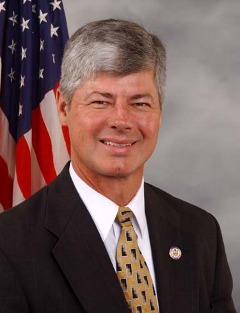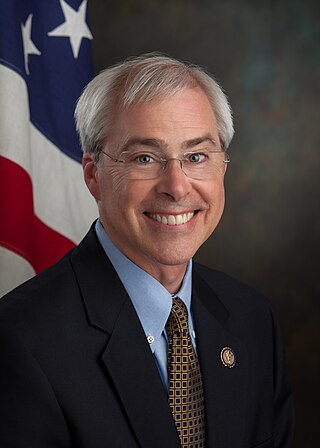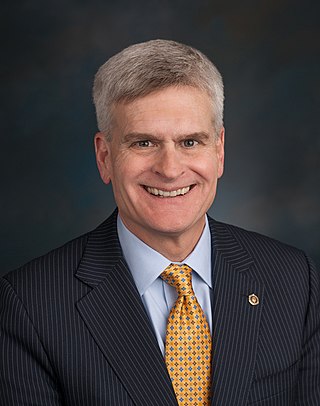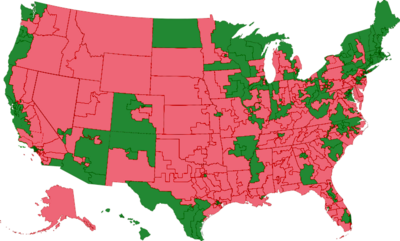
Michael Keith Simpson is an American politician and former dentist serving as the U.S. representative for Idaho's 2nd congressional district since 1999. The district covers most of the eastern portion of the state, including Idaho Falls, Pocatello, Sun Valley, Twin Falls and the northern two-thirds of Boise.

Bartholomew Thomas Stupak is an American politician and lobbyist. A member of the Democratic Party, Stupak served as the U.S. representative from Michigan's 1st congressional district from 1993 to 2011.

The Children's Health Insurance Program (CHIP) – formerly known as the State Children's Health Insurance Program (SCHIP) – is a program administered by the United States Department of Health and Human Services that provides matching funds to states for health insurance to families with children. The program was designed to cover uninsured children in families with incomes that are modest but too high to qualify for Medicaid. The program was passed into law as part of the Balanced Budget Act of 1997, and the statutory authority for CHIP is under title XXI of the Social Security Act.

John Jenkins Barrow is an American politician who was the U.S. representative for Georgia's 12th congressional district from 2005 to 2015. The district includes much of the Georgia side of the Central Savannah River Area and includes counties as far south as Coffee County and as far west as Laurens County. He is a member of the Democratic Party.

William Morgan Cassidy is an American physician and politician serving as the senior United States senator from Louisiana, a seat he has held since 2015. A member of the Republican Party, he served in the Louisiana State Senate from 2006 to 2009 and in the U.S. House of Representatives from 2009 to 2015.
In U.S. politics, the Hyde Amendment is a legislative provision barring the use of federal funds to pay for abortion, except to save the life of the woman, or if the pregnancy arises from incest or rape. Before the Hyde Amendment took effect in 1980, an estimated 300,000 abortions were performed annually using federal funds.
The Tax Parity for Health Plan Beneficiaries Act is a bill in the 112th Congress that would equalize tax treatment for employer-provided health coverage for domestic partners and other non-spouse, non-dependent beneficiaries."

Gerald Edward Connolly is an American politician serving as the U.S. representative for Virginia's 11th congressional district, first elected in 2008. The district is anchored in Fairfax County, an affluent suburban county west of Washington, D.C. It includes all of Fairfax City and part of Prince William County. Connolly is a member of the Democratic Party.

Former United States Senator Harry Reid declared his position on many political issues through his public comments and his senatorial voting record.
The history of health care reform in the United States has spanned many decades with health care reform having been the subject of political debate since the early part of the 20th century. Recent reforms remain an active political issue. Alternative reform proposals were offered by both of the major candidates in the 2008, 2016, and 2020 presidential elections.
The proposed America's Affordable Health Choices Act of 2009 was an unsuccessful bill introduced in the U.S. House of Representatives on July 14, 2009. The bill was introduced during the first session of the 111th Congress as part of an effort of the Democratic Party leadership to enact health care reform. The bill was not approved by the House, but was superseded by a similar bill, the proposed Affordable Health Care for America Act, which was passed by the House in November 2009, by a margin of 220-215 votes but later abandoned.
The public health insurance option, also known as the public insurance option or the public option, is a proposal to create a government-run health insurance agency that would compete with other private health insurance companies within the United States. The public option is not the same as publicly funded health care, but was proposed as an alternative health insurance plan offered by the government. The public option was initially proposed for the Patient Protection and Affordable Care Act, but was removed after independent Connecticut senator Joe Lieberman threatened a filibuster.
The Stupak–Pitts Amendment was a proposed amendment to the Affordable Health Care for America Act of 2010 (AHCAA). It was submitted by Representatives Bart Stupak and Joseph R. Pitts. Its stated purpose was to prohibit the use of federal funds "to pay for any abortion or to cover any part of the costs of any health plan that includes coverage of abortion" except in cases of rape, incest or danger to the life of the mother. It was adopted by the House but not included in the Senate's version, the Patient Protection and Affordable Care Act (PPACA). Representatives who support abortion rights said they would oppose AHCAA with the Stupak-Pitts language, and proposed to adopt PPACA. Stupak and several supporters said they would oppose PPACA without the amendment, but withdrew their opposition after President Obama promised an executive order to bar such funding. Anti-abortion groups criticized this action, saying that the executive order would not be effective.

The Affordable Care Act (ACA), formally known as the Patient Protection and Affordable Care Act and colloquially known as Obamacare, is a landmark U.S. federal statute enacted by the 111th United States Congress and signed into law by President Barack Obama on March 23, 2010. Together with the Health Care and Education Reconciliation Act of 2010 amendment, it represents the U.S. healthcare system's most significant regulatory overhaul and expansion of coverage since the enactment of Medicare and Medicaid in 1965.

The Health Care and Education Reconciliation Act of 2010 is a law that was enacted by the 111th United States Congress, by means of the reconciliation process, in order to amend the Affordable Care Act (ACA). The law includes the Student Aid and Fiscal Responsibility Act, which was attached as a rider.

The Hire More Heroes Act of 2013 is a bill that would allow employers to exclude veterans receiving health insurance from the United States Department of Defense or the United States Department of Veterans' Affairs from their list of employees. This would have the effect of keeping their list of employees shorter, allowing some small businesses to fall underneath the 50 full-time employees line that would require them to provide their employees with healthcare under the requirements of the Affordable Care Act. This change is seen by supporters as a way to incentivize small businesses to hire more veterans.

The Protecting Volunteer Firefighters and Emergency Responders Act is a bill that amends the Internal Revenue Code to exclude volunteer hours of volunteer firefighters and emergency medical personnel from counting towards the calculation of the number of a firm’s full-time employees for purposes of certain provisions of the Affordable Care Act. This would mean that there is no requirement that volunteer emergency responders be offered health care by the organization they volunteer with.

The Employee Health Care Protection Act of 2013 is a bill that would permit a health insurance issuer that has in effect health insurance coverage in the group market on any date during 2013 to continue offering such coverage for sale during 2014 outside of a health care exchange established under the Patient Protection and Affordable Care Act.
The following is a list of efforts to repeal the Affordable Care Act, which had been enacted by the 111th United States Congress on March 23, 2010.

The Executive Order Promoting Healthcare Choice and Competition, also known as the Trumpcare Executive Order, or Trumpcare, is an Executive Order signed by Donald Trump on October 12, 2017, which directs federal agencies to modify how the Patient Protection and Affordable Care Act of the Obama Administration is implemented. The order included a directive to federal agencies to end rules forbidding employers from using health reimbursement arrangements (HRAs) to pay individual insurance premiums.









